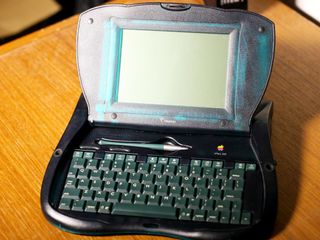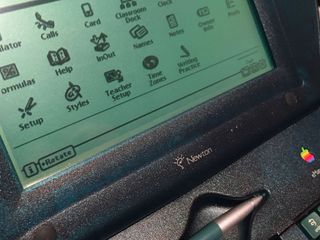The Apple Watch, Naked Lunch, and the eMate 300

All my life I've been fascinated by weird things. The weirder the better. Apple's product designs were really weird for a while. Weird, and really pretty.
The weirder the better
When I was a young teen in the 1980s, few things gave me as much pleasure as reading Fangoria magazine from bloody cover to bloody cover. Fangoria was — and is — a great magazine if you're interested in practical special effects in the movies, and at that age I was obsessed with gory movies.
One particular horror movie director who caught my attention was David Cronenberg. Cronenberg made his mark with unusual R-rated horror fare like Videodrome and my particular favorite, Scanners.
Cronenberg was tapped to direct Naked Lunch, a movie adaptation of William S. Burroughs' surreal beat generation novel of vignettes based on his own experiences traveling internationally.

Cronenberg used nightmarish visuals in his interpretation, none more disturbing than the talking insectoid typewriter that speaks from a sphincter hidden under its shell. I found its image to be fascinating, disturbing and even stomach-churning, but I couldn't look away.

One of Apple's old industrial designs makes me think of the alien typewriter, but if it was cuddly, not scary. It's the jeweled, green eMate 300, looking chitinous but oddly inviting.
The Swatch Generation
Apple's disrupted more industries than you can shake a stick at. Nicholas Hayek disrupted an industry too, after he launched Swatch in 1983. The company manufactures watches and is based in Switzerland.
Master your iPhone in minutes
iMore offers spot-on advice and guidance from our team of experts, with decades of Apple device experience to lean on. Learn more with iMore!
Swatches became all the rage to a generation of teens in the 1980s when they started coming out with creative and imaginative designs that matched the pop culture zeitgeist of the age.
Swatches weren't as cheap as the knockoffs you'd find at lesser department stores and malls, but having a Swatch on your wrist became just as much of a status symbol as having a pair of Air Jordan sneakers or the right denim jacket.
A brief history of touch
We take it for granted these days that Apple has pioneered and mastered many of the techniques used in touch interface technology for smart devices. Hundreds of thousands of developers write millions of lines of code and make billions of dollars selling apps for those devices through the App Store. But this isn't Apple's first round of touch-based screen input technology. Years before the iPhone, years before the iPod, there was the Newton MessagePad.
The Newton was famously unsuccessful, but that didn't stop Apple trying cool things with it. I have an original MessagePad, but my favorite piece of Newton memorabilia is my eMate 300. The eMate 300 is a laptop computer based on Newton tech.

The eMate 300 was in production for less than a year starting in 1997, but for many of us old-timey Apple fans, it was a memorable run. It ran for up to 28 hours between charges on a rechargeable battery, included networking and had an expansion card. It didn't have a hard disk; the eMate 300 stored everything in non-volatile memory, just like today's smart devices.
The unique translucent design of the eMate 300 was the idea of Thomas Meyerhoffer, who created the shell to evoke a sense of accessibility.
The shell suggests but doesn't actually reveal the hardware that's inside. There's an air of mystery to the eMate 300, a jeweled murkiness that makes you wonder what's inside.
The built-in keyboard made it easy to input lots of data into the device, which used a touch-sensitive LCD screen you could write on with the included stylus. Using the Newton OS is nothing like using Macs or iOS devices now, but there are familiar ideas afoot, like a document and activity-based workflow and the mirroring of real world gestures to affect what's happening on the screen.
There was even handwriting recognition; initially it was the emphasis of many criticisms for its poor interpretation. Apple got it right, but it took them longer than it should have. By the time it got to the eMate 300 it was pretty solid.
The eMate 300 was built for smaller hands and was envisioned as a way of getting computers into the hands of schoolkids. If Apple had been in a different place with different fortunes at the time, kids all over the country might have used eMates instead of iPads, as many are now.
It was a very different Apple at a very different time, but you can still see the spirit of innovation in today's products, right down to the Apple Watch.
It'll be interesting to see how the Apple Watch is received by multiple generations of Apple users. As a Swatch kid, now an adult with a family of my own, I'm getting a distinct sense of deja vu.
Most Popular





